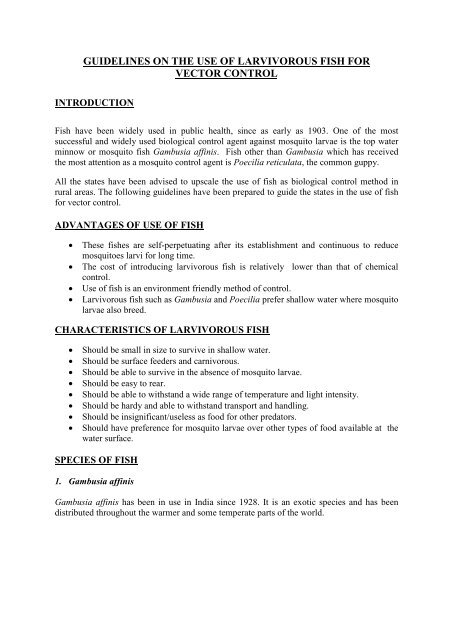guidelines on the use of larvivorous fish for vector control - NVBDCP
guidelines on the use of larvivorous fish for vector control - NVBDCP
guidelines on the use of larvivorous fish for vector control - NVBDCP
Create successful ePaper yourself
Turn your PDF publications into a flip-book with our unique Google optimized e-Paper software.
Submerged vegetati<strong>on</strong> such as hydrilla, vallisneria should be available in <strong>the</strong> tanks. Salinity <strong>of</strong> water should not exceed 20 grams per litre. These <strong>fish</strong> may survive salinityup to 52 gms. per litre. But it cannot reproduce at this salinity level. Hatchery should not be subjected to str<strong>on</strong>g water current and should be protectedfrom heavy rains and floods. Entire tanks should be brick made, lined with good quality <strong>of</strong> cement plaster, thikness<strong>of</strong> wall about 0.5 m. The tank should be divided into two porti<strong>on</strong>s <strong>of</strong> equal size <strong>of</strong> 5 m X 4 m with centralseparator <strong>of</strong> 0.5 m thick. Area – sufficiently big <strong>for</strong> c<strong>on</strong>structi<strong>on</strong> <strong>of</strong> 2 tanks <strong>of</strong> 5 m X 4 m (<strong>on</strong>e <strong>for</strong> laying young<strong>on</strong>es and o<strong>the</strong>r <strong>for</strong> holding mature full grown <strong>fish</strong>). Depth <strong>of</strong> water in <strong>the</strong> hatchery should be 1.5 m. Proper outlet at <strong>the</strong> bottom <strong>of</strong> tank should be provided. Overflow outlet about 5 cm below inlet protected with proper wire mesh to preventescape <strong>of</strong> <strong>fish</strong>. Floor <strong>of</strong> tank 0.5 m thick with slope from <strong>the</strong> partiti<strong>on</strong> towards sides. Proper inlet at 1.25 m height. Bottom <strong>of</strong> tank covered with uni<strong>for</strong>m thickness <strong>of</strong> sand <strong>for</strong> about 10 cm.The bottom should be seeded with organic matter about 2 kg/m 2.The tank should be allowed to mature <strong>for</strong> 10–15 days.Minimum 25% <strong>of</strong> water should be replaced <strong>on</strong>ce a week.The <strong>fish</strong>es should be tranfered from <strong>the</strong> tank to avoid over populati<strong>on</strong>.In case <strong>of</strong> scarcity <strong>of</strong> natural food, artificial food such as waste flour (atta) may begiven. Chlorinati<strong>on</strong> <strong>of</strong> water bey<strong>on</strong>d <strong>the</strong> tolerance levels, or presence <strong>of</strong> insecticidescan be lethal to <strong>the</strong> <strong>fish</strong>.TRANSPORTATION OF FISHThe <strong>fish</strong> are best transported in small c<strong>on</strong>tainers <strong>of</strong> up to 40 litres, such as plasticbuckets and jerry cans, or in str<strong>on</strong>g plastic bags, half filled with water from <strong>the</strong>rearing p<strong>on</strong>d.Fish should be transported in water at ambient temperatures and should not beexposed to direct sunlight. The c<strong>on</strong>tainers should have sufficient openings to allowflow <strong>of</strong> air.Take poly<strong>the</strong>ne bag <strong>of</strong> 3 -5 litre capacity.Fill it with 1.5 lit. <strong>of</strong> water.Introduce <strong>the</strong> <strong>fish</strong> in <strong>the</strong> bag till <strong>the</strong> total volume <strong>of</strong> water + <strong>fish</strong> is two litres.Bubble <strong>the</strong> oxygen in bag from O 2 cylinder or from air pump.Close <strong>the</strong> mouth <strong>of</strong> bag with a string leaving sufficient space at <strong>the</strong> top.Put <strong>the</strong> bag in a <strong>the</strong>rmocol c<strong>on</strong>tainer and close <strong>the</strong> mouth <strong>of</strong> c<strong>on</strong>tainer.The c<strong>on</strong>tainer can be transported <strong>for</strong> a period <strong>of</strong> 24 hours without fur<strong>the</strong>r fillingoxygen. If <strong>the</strong> period <strong>of</strong> transport is more than 24 hours <strong>the</strong>n arrange <strong>for</strong> change <strong>of</strong>water and oxygenate.
Collecti<strong>on</strong> <strong>of</strong> <strong>fish</strong>esFishes are collected with help <strong>of</strong> netting, which is fitted <strong>on</strong> a circular ir<strong>on</strong> ring <strong>of</strong> 60 to90 cm diameter with a wooden handle.Sufficient quantity is collected by repeated dips.Collecti<strong>on</strong> in bucket or drum till <strong>the</strong>y are packed <strong>for</strong> transportati<strong>on</strong>.Precauti<strong>on</strong> during Transportati<strong>on</strong>Fish do not tolerate sudden temperature changes.Preferably <strong>the</strong> <strong>fish</strong>es should not be given any food <strong>for</strong> 10–12 hours period prior topacking <strong>for</strong> transportati<strong>on</strong>.RELEASE OF FISHTo release <strong>the</strong> <strong>fish</strong> in a water body, measure <strong>the</strong> perimeter <strong>of</strong> water body.Release <strong>the</strong> <strong>fish</strong>es at <strong>the</strong> rate <strong>of</strong> 5–10 <strong>fish</strong> per linear meter.If <strong>the</strong> larval density is high more <strong>fish</strong> up to 20 can be released.Precauti<strong>on</strong>s during release <strong>of</strong> <strong>fish</strong>:Fishes should be released in <strong>the</strong> morning hours or in <strong>the</strong> evening.Be<strong>for</strong>e releasing ensure that <strong>the</strong> temperature <strong>of</strong> water both in c<strong>on</strong>tainer and in <strong>the</strong>larval habitat is more or less same.Clean out dense vegetati<strong>on</strong> from <strong>the</strong> water body.Ensure that water body is free from predators <strong>of</strong> <strong>larvivorous</strong> <strong>fish</strong>es.WHERE TO USE FISHFish should be preferably introduced in all un<strong>use</strong>d wells in <strong>the</strong> rural and peri-urbanareas be<strong>for</strong>e <strong>the</strong> high mosquito breeding seas<strong>on</strong> to maximize impact. However, <strong>the</strong><strong>fish</strong> may be <strong>use</strong>d in such wells even if <strong>the</strong> seeding has been delayed.Fresh water bodies in rural areas such as stagnant p<strong>on</strong>ds, slow moving streams quarrypits, large borrow pits, margins <strong>of</strong> p<strong>on</strong>ds should be targetted apart from wells. Suchplaces should be surveyed and numbered to facilitate subsequent m<strong>on</strong>itoring <strong>of</strong>impact.In open mosquito breeding sites or rice fields, <strong>the</strong> <strong>fish</strong>es need to be protected frompesticides applied to crops, when <strong>use</strong>d in rice fields.MONITORINGSupervisors should check <strong>the</strong> <strong>fish</strong> hatcheries at least <strong>on</strong>ce a m<strong>on</strong>th during <strong>the</strong> hightransmissi<strong>on</strong> seas<strong>on</strong>.At least 10% <strong>of</strong> <strong>the</strong> sites where <strong>fish</strong> have been introduced should be checked <strong>for</strong>:o Whe<strong>the</strong>r <strong>fish</strong> have been introduced or noto Whe<strong>the</strong>r <strong>the</strong> <strong>fish</strong> are surviving or noto Identificati<strong>on</strong> <strong>of</strong> possible reas<strong>on</strong>s, in case <strong>the</strong> introduced <strong>fish</strong> are not surviving.
REPORTINGM<strong>on</strong>thly report to state programme <strong>of</strong>ficer and to NAMP c<strong>on</strong>taining followingin<strong>for</strong>mati<strong>on</strong>:o Number <strong>of</strong> <strong>fish</strong> hatcheries establishedo Name <strong>of</strong> urban and rural areas using <strong>larvivorous</strong> <strong>fish</strong>o Number <strong>of</strong> un<strong>use</strong>d wells marked <strong>for</strong> <strong>the</strong> introducti<strong>on</strong> <strong>of</strong> <strong>the</strong> <strong>fish</strong>o Number <strong>of</strong> sites in <strong>the</strong> urban areas marked <strong>for</strong> <strong>the</strong> introducti<strong>on</strong> <strong>of</strong> <strong>the</strong> <strong>fish</strong>.o Field reports <strong>of</strong> supervisi<strong>on</strong> <strong>of</strong> 10% <strong>of</strong> <strong>the</strong> sitesCommunity participati<strong>on</strong> and resp<strong>on</strong>se.
















